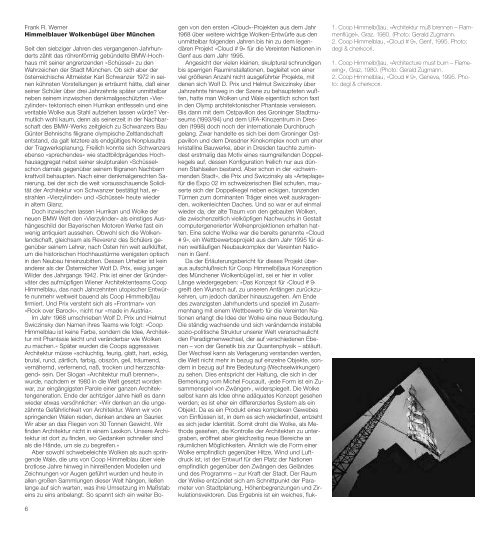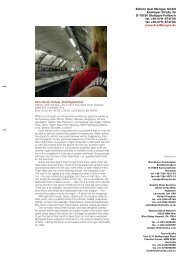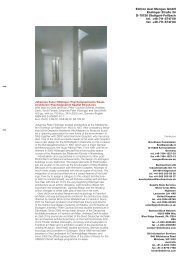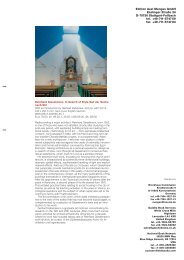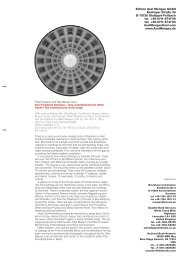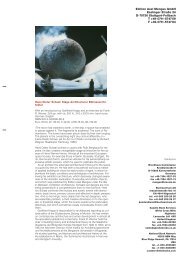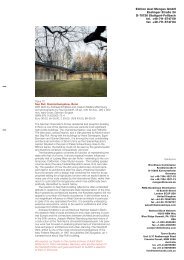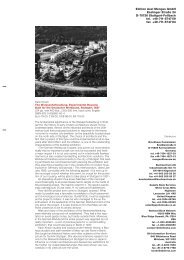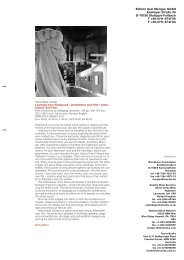Opus 54. Eiermann, Wash, d - Edition Axel Menges
Opus 54. Eiermann, Wash, d - Edition Axel Menges
Opus 54. Eiermann, Wash, d - Edition Axel Menges
Sie wollen auch ein ePaper? Erhöhen Sie die Reichweite Ihrer Titel.
YUMPU macht aus Druck-PDFs automatisch weboptimierte ePaper, die Google liebt.
Frank R. Werner<br />
Himmelblauer Wolkenbügel über München<br />
Seit den siebziger Jahren des vergangenen Jahrhunderts<br />
zählt das röhrenförmig gebündelte BMW-Hochhaus<br />
mit seiner angrenzenden »Schüssel« zu den<br />
Wahrzeichen der Stadt München. Ob sich aber der<br />
österreichische Altmeister Karl Schwanzer 1972 in seinen<br />
kühnsten Vorstellungen je erträumt hätte, daß einer<br />
seiner Schüler über drei Jahrzehnte später unmittelbar<br />
neben seinem inzwischen denkmalgeschützten »Vierzylinder«<br />
tektonisch einen Hurrikan entfesseln und eine<br />
veritable Wolke aus Stahl aufziehen lassen würde? Vermutlich<br />
wohl kaum, denn als seinerzeit in der Nachbarschaft<br />
des BMW-Werks zeitgleich zu Schwanzers Bau<br />
Günter Behnischs filigrane olympische Zeltlandschaft<br />
entstand, da galt letztere als endgültiges Nonplusultra<br />
der Tragwerksplanung. Freilich konnte sich Schwanzers<br />
ebenso »sprechendes« wie stadtbildprägendes Hochhausaggregat<br />
nebst seiner skulpturalen »Schüssel«<br />
schon damals gegenüber seinem filigranen Nachbarn<br />
kraftvoll behaupten. Nach einer denkmalgerechten Sanierung,<br />
bei der sich die weit vorausschauende Solidität<br />
der Architektur von Schwanzer bestätigt hat, erstrahlen<br />
»Vierzylinder« und »Schüssel« heute wieder<br />
in altem Glanz.<br />
Doch inzwischen lassen Hurrikan und Wolke der<br />
neuen BMW Welt den »Vierzylinder« als einstiges Aushängeschild<br />
der Bayerischen Motoren Werke fast ein<br />
wenig antiquiert aussehen. Obwohl sich die Wolkenlandschaft,<br />
gleichsam als Reverenz des Schülers gegenüber<br />
seinem Lehrer, nach Osten hin weit aufklüftet,<br />
um die historischen Hochhaustürme wenigsten optisch<br />
in den Neubau hineinzubitten. Dessen Urheber ist kein<br />
anderer als der Österreicher Wolf D. Prix, ewig junger<br />
Wilder des Jahrgangs 1942. Prix ist einer der Gründerväter<br />
des aufmüpfigen Wiener Architektenteams Coop<br />
Himmelblau, das nach Jahrzehnten utopischer Entwürfe<br />
nunmehr weltweit bauend als Coop Himmelb(l)au<br />
firmiert. Und Prix versteht sich als »Frontman« von<br />
»Rock over Barock«, nicht nur »made in Austria«.<br />
Im Jahr 1968 umschrieben Wolf D. Prix und Helmut<br />
Swiczinsky den Namen ihres Teams wie folgt: »Coop<br />
Himmelblau ist keine Farbe, sondern die Idee, Architektur<br />
mit Phantasie leicht und veränderbar wie Wolken<br />
zu machen.« Später wurden die Coops aggressiver.<br />
Architektur müsse »schluchtig, feurig, glatt, hart, eckig,<br />
brutal, rund, zärtlich, farbig, obszön, geil, träumend,<br />
vernähernd, verfernend, naß, trocken und herzzschlagend«<br />
sein. Der Slogan »Architektur muß brennen«,<br />
wurde, nachdem er 1980 in die Welt gesetzt worden<br />
war, zur eingängigsten Parole einer ganzen Architektengeneration.<br />
Ende der achtziger Jahre hieß es dann<br />
wieder etwas versöhnlicher: »Wir denken an die ungezähmte<br />
Gefährlichkeit von Architektur. Wenn wir von<br />
springenden Walen reden, denken andere an Saurier.<br />
Wir aber an das Fliegen von 30 Tonnen Gewicht. Wir<br />
finden Architektur nicht in einem Lexikon. Unsere Architektur<br />
ist dort zu finden, wo Gedanken schneller sind<br />
als die Hände, um sie zu begreifen.«<br />
Aber sowohl schwebeleichte Wolken als auch springende<br />
Wale, die uns von Coop Himmelblau über viele<br />
brotlose Jahre hinweg in hinreißenden Modellen und<br />
Zeichnungen vor Augen geführt wurden und heute in<br />
allen großen Sammlungen dieser Welt hängen, ließen<br />
lange auf sich warten, was ihre Umsetzung im Maßstab<br />
eins zu eins anbelangt. So spannt sich ein weiter Bo-<br />
gen von den ersten »Cloud«-Projekten aus dem Jahr<br />
1968 über weitere wichtige Wolken-Entwürfe aus den<br />
unmittelbar folgenden Jahren bis hin zu dem legendären<br />
Projekt »Cloud # 9« für die Vereinten Nationen in<br />
Genf aus dem Jahr 1995.<br />
Angesicht der vielen kleinen, skulptural schrundigen<br />
bis sperrigen Rauminstallationen, begleitet von einer<br />
viel größeren Anzahl nicht ausgeführter Projekte, mit<br />
denen sich Wolf D. Prix und Helmut Swiczinsky über<br />
Jahrzehnte hinweg in der Szene zu behaupteten wußten,<br />
hatte man Wolken und Wale eigentlich schon fast<br />
in den Olymp architektonischer Phantasie verwiesen.<br />
Bis dann mit dem Ostpavillon des Groninger Stadtmuseums<br />
(1993/94) und dem UFA-Kinozentrum in Dresden<br />
(1998) doch noch der internationale Durchbruch<br />
gelang. Zwar handelte es sich bei dem Groninger Ostpavillon<br />
und dem Dresdner Kinokomplex noch um eher<br />
kristalline Bauwerke, aber in Dresden tauchte zumindest<br />
erstmalig das Motiv eines raumgreifenden Doppelkegels<br />
auf, dessen Konfiguration freilich nur aus dünnen<br />
Stahlseilen bestand. Aber schon in der »schwimmenden<br />
Stadt«, die Prix und Swiczinsky als »Arteplage«<br />
für die Expo 02 im schweizerischen Biel schufen, mauserte<br />
sich der Doppelkegel neben eckigen, tanzenden<br />
Türmen zum dominanten Träger eines weit auskragenden,<br />
wolkenleichten Daches. Und so war er auf einmal<br />
wieder da, der alte Traum von den gebauten Wolken,<br />
die zwischenzeitlich vielköpfigen Nachwuchs in Gestalt<br />
computergenerierter Wolkenprojektionen erhalten hatten.<br />
Eine solche Wolke war die bereits genannte »Cloud<br />
# 9«, ein Wettbewerbsprojekt aus dem Jahr 1995 für einen<br />
weitläufigen Neubaukomplex der Vereinten Nationen<br />
in Genf.<br />
Da der Erläuterungsbericht für dieses Projekt überaus<br />
aufschlußreich für Coop Himmelb(l)aus Konzeption<br />
des Münchener Wolkenbügel ist, sei er hier in voller<br />
Länge wiedergegeben: »Das Konzept für ›Cloud # 9‹<br />
greift den Wunsch auf, zu unseren Anfängen zurückzukehren,<br />
um jedoch darüber hinauszugehen. Am Ende<br />
des zwanzigsten Jahrhunderts und speziell im Zusammenhang<br />
mit einem Wettbewerb für die Vereinten Nationen<br />
erlangt die Idee der Wolke eine neue Bedeutung.<br />
Die ständig wachsende und sich verändernde instabile<br />
sozio-politische Struktur unserer Welt veranschaulicht<br />
den Paradigmenwechsel, der auf verschiedenen Ebenen<br />
– von der Genetik bis zur Quantenphysik – abläuft.<br />
Der Wechsel kann als Verlagerung verstanden werden,<br />
die Welt nicht mehr in bezug auf einzelne Objekte, sondern<br />
in bezug auf ihre Bedeutung (Wechselwirkungen)<br />
zu sehen. Dies entspricht der Haltung, die sich in der<br />
Bemerkung vom Michel Foucault, ›jede Form ist ein Zusammenspiel<br />
von Zwängen‹, widerspiegelt. Die Wolke<br />
selbst kann als Idee ohne adäquates Konzept gesehen<br />
werden; es ist eher ein differenziertes System als ein<br />
Objekt. Da es ein Produkt eines komplexen Gewebes<br />
von Einflüssen ist, in dem es sich wiederfindet, entzieht<br />
es sich jeder Identität. Somit droht die Wolke, als Methode<br />
gesehen, die Kontrolle der Architekten zu untergraben,<br />
eröffnet aber gleichzeitig neue Bereiche an<br />
räumlichen Möglichkeiten. Ähnlich wie die Form einer<br />
Wolke empfindlich gegenüber Hitze, Wind und Luftdruck<br />
ist, ist der Entwurf für den Platz der Nationen<br />
empfindlich gegenüber den Zwängen des Geländes<br />
und des Programms – zur Kraft der Stadt. Der Raum<br />
der Wolke entzündet sich am Schnittpunkt der Parameter<br />
von Stadtplanung, Höhenbegrenzungen und Zirkulationsvektoren.<br />
Das Ergebnis ist ein weiches, fluk-<br />
1. Coop Himmelb(l)au, »Architektur muß brennen – Flammenflügel«,<br />
Graz, 1980. (Photo: Gerald Zugmann.<br />
2. Coop Himmelblau, »Cloud # 9«, Genf, 1995. Photo:<br />
degl & cherkoori.<br />
1. Coop Himmelb(l)au, »Architecture must burn – Flamewing«,<br />
Graz, 1980. (Photo: Gerald Zugmann.<br />
2. Coop Himmelblau, »Cloud # 9«, Geneva, 1995. Photo:<br />
degl & cherkoori.<br />
Frank R. Werner<br />
Sky-blue cloud hanger over Munich<br />
The bundle of tubes forming the BMW tower, and the<br />
»Bowl« adjacent to it, have been Munich landmarks<br />
since the 1960s. But I wonder whether Austrian old<br />
master Karl Schwanzer imagined even in his wildest<br />
dreams that over three decades later one of his pupils<br />
would unleash a tectonic hurricane immediately adjacent<br />
to his »Four Cylinders«, by now a listed building,<br />
and send a veritable cloud of steel soaring above the<br />
site? I rather think not, as when Günter Behnisch’s filigree<br />
Olympic tent landscape was created near the<br />
BMW factory at the same time as Schwanzer’s building,<br />
Behnisch’s work was considered the non plus ultra<br />
for structural engineering. Admittedly Schwanzer’s tower<br />
unit, as »eloquent« as it is a striking feature in the<br />
cityscape, and its sculptural »Bowl« were well able to<br />
hold their own at the time against their filigree neighbours.<br />
The »Four Cylinders« and the »Bowl« have been<br />
refurbished appropriately to their listed status, confirming<br />
the far-sighted solidity of Schwanzer’s architecture,<br />
and they now shine out again in all their old glory.<br />
But in the meantime the hurricane and cloud of the<br />
new BMW Welt make the »Four Cylinders« look almost<br />
a little antiquated as the former flagship of the Bayerische<br />
Motoren Werke. Though the cloud landscape,<br />
almost as an acknowledgment of the teacher by his<br />
pupil, does open itself out wide to the east, so that the<br />
historical skyscraper towers are invited into the new<br />
building, visually at least. The creator of this cloud landscape<br />
is no other than the Austrian architect Wolf D.<br />
Prix, an eternal young tearaway born in 1942. Prix is<br />
one of the founding fathers of the rebellious Viennese<br />
architecture team Coop Himmelblau, which after decades<br />
of Utopian designs now trades as Coop Himmelb(l)au,<br />
building all over the world. And Prix sees himself<br />
as a »front man« of »Rock over Barock«, not only<br />
»made in Austria«.<br />
In 1968, Wolf D. Prix and Helmut Swiczinsky defined<br />
their team’s name like this: »Coop Himmelblau is not a<br />
colour, but the idea of using imagination to make architecture<br />
that is as light and changeable as clouds.« Later<br />
the Coops became more aggressive, saying that architecture<br />
must be »fissured, fiery, smooth, hard, angular,<br />
brutal, round, tender, colourful, obscene, randy, dreamy,<br />
approachable, forbidding, wet, dry and heart-stopping«.<br />
The slogan »architecture must burn«, after coming into<br />
the world in 1980, became the catchiest motto for a<br />
whole generation of architects in the seventies. Then in<br />
the late eighties things turned a little more conciliatory<br />
again: »We are thinking of the untamed danger inherent<br />
in architecture. When we talk about leaping whales,<br />
other people think of dinosaurs. But we think of thirty<br />
tons of flying weight. We do not find architecture in an<br />
encyclopaedia. Our architecture is to be found where<br />
thoughts are quicker to grasp it than hands.«<br />
But both the floating clouds and the leaping whales<br />
that Coop Himmelblau showed us over many hungry<br />
years in their enchanting models and drawings that<br />
now hang in all the world’s great collections kept us<br />
waiting for a long time to be realized on a one-to-one<br />
scale. So it is a very long way from the first »Cloud«<br />
project in 1968 via other important cloud designs in<br />
the years immediately after that until the legendary<br />
»Cloud # 9« project for the United Nations in Geneva<br />
in 1995.<br />
Given the many small, sculpturally fissured to unwieldy<br />
room installations, accompanied by a much larger<br />
number of unrealized projects, with which Wolf D.<br />
Prix and Helmut Swiczinsky managed to make their<br />
mark on the scene for decades, clouds and whales had<br />
actually almost been relegated to the Olympus of architectural<br />
imagination. But then the international breakthrough<br />
actually did take place with the east pavilion for<br />
the municipal museum in Groningen (1993/94) and the<br />
UFA cinema centre in Dresden (1998). In fact the east<br />
pavilion in Groningen and the Dresden cinema complex<br />
were still more like crystalline buildings, but at least the<br />
motif of an extensive double cone cropped up in Dresden<br />
for the first time, though admittedly its configuration<br />
consisted only of thin steel cables. But as soon as the<br />
»floating city« that Prix and Swiczinsky created as an<br />
»Arteplage« for Expo 02 in the Swiss city of Biel, the<br />
double cone, along with angular, dancing towers, blossomed<br />
into the dominant support for a widely protruding,<br />
cloud-light roof. And so it was back again, that old<br />
dream of built clouds that had had many descendants<br />
in the meantime in the form of computer-generated<br />
cloud projections. The above mentioned »Cloud # 9«,<br />
a competition project dating from 1955, an extensive<br />
new complex for the United Nations in Geneva, was a<br />
cloud of this kind.<br />
As the explanatory report on this project is extremely<br />
revealing about Coop Himmelb(l)au’s concept for the<br />
Munich cloud hanger, I shall quote it in full here: »The<br />
concept for ›Cloud # 9‹ takes up the desire to go back<br />
to our beginnings, but to go beyond them as well. The<br />
cloud idea acquired a new meaning in the late twentieth<br />
century, and particularly in the context of a competition<br />
for the United Nations. The constantly growing and<br />
changing unstable socio-political structure of our world<br />
illustrates the paradigm shift that is happening on a<br />
number of levels – from genetics to quantum physics.<br />
The change can be seen as a shift to not seeing the<br />
world in terms of individual objects any more, but in<br />
terms of their meaning (interplay). This fits in with the<br />
approach reflected in Michel Foucault’s remark ›every<br />
form is an interplay of constraints‹. The cloud itself can<br />
be seen as an idea without an appropriate concept; it is<br />
more like a sophisticated system than an object. As it is<br />
the product of a complex fabric of influences in which it<br />
finds itself again, it withdraws from any sense of identity.<br />
Thus, seen as a method, the cloud threatens to undermine<br />
architects’ control, but at the same time opens up<br />
new realms of spatial possibilities. Similarly to the way<br />
the shape of a cloud is susceptible to heat, wind and<br />
atmospheric pressure, the design for the Place des Nations<br />
is susceptible to the constraints of the site and the<br />
programme – to the power of the city. The cloud space<br />
ignites at the interface between the parameters of<br />
town planning, height restrictions and circulation vectors.<br />
The result is a soft, fluctuating enigma – a building<br />
that does not want to be a building any longer. The<br />
cloud envelope becomes a glass-like net structure,<br />
loosely defining a semi-public space. The permeability<br />
of this shell makes it possible to see people moving<br />
about, through layers of light and colour. The space becomes<br />
both a point of intersection for diplomats, students<br />
and tourists and also the city of Geneva’s access<br />
to the United Nations International Zone. Private office<br />
buildings from consulates and missions rise up from the<br />
concrete lift shafts in this zone. The space between the<br />
envelope and the solid structure, used for balconies<br />
6 7


